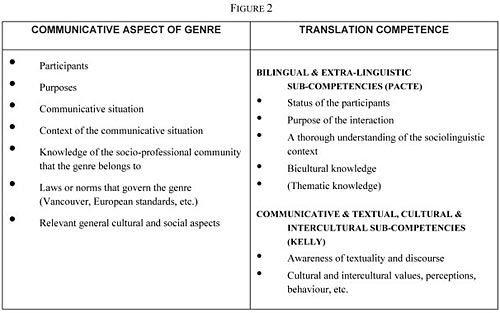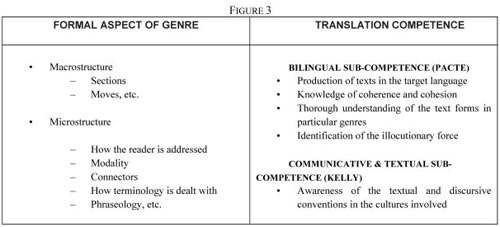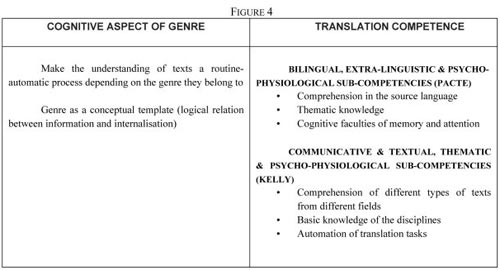
- •Lecture 3. Teaching Translation of Text Types with mt Error Analysis and Post-mt Editing
- •1. Introduction
- •2. Text Types
- •3. Mt Errors and Post-mt Editing
- •4. Methodology
- •5. Findings. Students' mt error statistics
- •6. Using mt error analysis to identify text types
- •7. Learning dominant linguistic features of the three text types
- •8. Awareness of the relevance of text types to translation
- •1. Premises
- •2. Translation competence and its acquisition or concepts and misconceptions about translator training
- •4. Questionnaires
- •5. Forum
- •6. Learners' assessment
- •7. Achievements and limits of pedagogic technology
- •1. Introduction
- •1. Introduction
- •3. Corpora and trainee translator’s professional prospect
- •4. The Present Picture
- •5. Ailing System of Teaching Translation in Universities
- •6. Major Weaknesses of Translation Teaching at Universities
- •7. The Necessity of Viewing Translation as a Learning Process
- •Importance of Testing
- •1. Introduction
- •Introduction
- •2. Translation competence
- •3. The concept of text genre
- •4. Relation between the text genre and the different sub-competencies of tc
- •5. Teaching proposal
- •6. Conclusion
4. Relation between the text genre and the different sub-competencies of tc
Genre can be defined as a multifaceted concept that is made up of three complementary perspectives: a) the socio-communicative perspective, which considers the space around the participants, the relationships that are established between them and the actions they carry out; b) the formal perspective, that is to say, the conventional elements that correspond to the readers' expectations generated by the socio-communicative context guiding the processes of creating and understanding the text; c) the cognitive perspective, or the ways each community understands, organizes and transforms the reality that surrounds them. As a result, it can be considered to be a category that plays a vital role when it comes to planning the teaching of translation and acquiring translation competence, which is the ultimate aim of education in this field.
We will therefore attempt to determine the relationship that exists between the characterization of the category text genre in each of these perspectives and the definitions that have been put forward for each of the sub-competencies that make up translation competence. By doing so our intention is to search for the existence of links (especially those referring to textual and communicative issues) that can help us to confirm our initial hypothesis.
For a genre to be considered as such, it must be a communicative phenomenon that is recognized and shared by the members of the professional or academic community in which it occurs. Furthermore, whether they belong to a socio-professional community or not is determined not only by having common objectives and knowledge within their areas of knowledge, but also, and necessarily, by the fact that they are familiar with the genres they commonly use to interact with each other and to do their work. Working on text genres makes it possible to identify a series of elements, such as the agents playing the roles of sender and receiver, the relationship that is established between them in terms of power or authority, the degree of specialization they offer and the situational context in which the genre in question occurs. So, in its communicative dimension, genre identifies the situation and the context of the communication situation; it also designates the participants, the relationship that arises between them and the purpose of the action. Likewise, it enables the socio-professional community to which the genre belongs to acquire knowledge about the possible norms or laws that govern them (European standards, Vancouver guidelines - in the case of genres used in biomedical research journals - and so forth) and also about relevant social and cultural aspects.
As far as the practice of translation is concerned, genre competence can help to:
Establish the status of the participants and the degree of authority they each have.
Infer and create the purpose of the interaction.
Recognize and establish the situationality of the source and target texts
Infer and create the intentionality of the source text.
Have a thorough understanding of the socio-linguistic context.
Acquire bicultural knowledge
Acquire thematic knowledge
It thus plays a part in improving or consolidating abilities and skills that are related to the bilingual and extra-linguistic sub-competencies. These sub-competencies have to do with appropriate comprehension and production in diverse socio-linguistic contexts, which depend on factors such as the participants' status, the purpose of the interaction, the norms or conventions governing the interaction, and so forth. Genre competence may also help to:
- increase awareness of textuality and discourse; this makes it possible to infer and create acceptability, which refers to the attitude of the receivers, who must perceive the text as being relevant and as being important to them because it enables them to cooperate with the person they are speaking to in the construction of a discursive goal.
- recognize cultural and intercultural values, perceptions, behavior, etc. and thus further the processes of comprehending and reformulating the communicative conventions that are typical of certain cultures or social groups.
It can facilitate improvement or consolidation of abilities and skills related to the communicative and textual and cultural and intercultural sub-competencies because it promotes the development of the capacity to understand, analyze and produce texts that are compatible with the genres and subgenres present both in the source culture and in the culture where the target language is used.

From the formal perspective we see genres as being structured, conventionalized phenomena, and if we understand convention to be: a device, principle, procedure or form which is generally accepted and through which there is an agreement between the writer and his readers which allows him various freedoms and restrictions (Cuddon)
Then it can be concluded that there must be a group that recognizes the mechanism and the existence of an agreement among members of that group to ensure that their behavior always follows the same pattern. At the same time, although variations can be introduced into this pattern and there are areas that allow a certain amount of leeway, it also complies with a series of restraints or stable areas, which are what allow participants to recognize the communicative intention and, hence, the genre.
The conventions that characterize genres are the formal traits that have been sanctioned by the community that uses them, rather than others that would be linguistically acceptable but do not fit the previously agreed patterns. These include the directly observable elements of the communicative event, such as its macrostructural characteristics, for example, structure, sections, moves, and also the intratextual or microstructural aspects it offers (including the degree of formality of the discourse used and the way the reader is addressed, the modality, the connectors, the lexical items that are employed, the degree of terminological density, the phraseology, the utilization of non-verbal graphic elements).
Depending on the nature of each genre, some parameters will be more important than others. For example, in the case of the genre certificate of quality aspects concerning the thematic progression and cohesion or the tenor are reduced to the minimum expression while the macrostructure is an extremely valuable feature. In genres such as the patent or the patient information leaflet the intratextual elements are highly conventionalized, while in others, like the instruction manual, the tenor plays a prominent role. When it comes to translation not all the parameters are equally important either; the focus tends towards the macrostructural and intratextual areas, where there are differences in the way conventions are used in the source culture and the target culture.
In teaching translation, genre competence in its formal dimension can help to enhance the following skills and abilities in the translator:
Recognizing and establishing the structure of the ST and TT;
Recognizing the texture of the source text and organizing that of the target text (selection of lexical items, syntactic organization, cohesion);
A thorough understanding of the text forms of particular genres;
Developing reformulation strategies such as: paraphrasing, summarizing, avoiding calques, and so forth;
Producing appropriate texts in the target language.
It therefore helps to improve or consolidate abilities and skills related to the bilingual sub-competence, as well as allowing translators to become aware of the textual and discursive conventions in the cultures involved.
Hence, it facilitates the improvement or consolidation of abilities and skills related to the communicative and textual sub-competence because it helps in the development of the capacity to understand, analyze and produce texts that are compatible with the characteristics and conventions of the genres and subgenres present in the cultures involved.

We can also compare the relations between genre and translation competence from the cognitive perspective. From this perspective, genre competence may allow the comprehension of texts to become a routine and/or automated process, depending on the genre they belong to. It may also act as a conceptual template in that it allows logical relationships to be established between information and its internalization.
Thus, genre, in its cognitive dimension, can help to enhance the following skills and abilities of the translator:
Identifying the type of information depending on the section or subsection in which it appears;
Understanding the implicit information of the genre in question, depending on the type of reader;
Understanding the degree to which information is made explicit according to the reader's needs;
Automating the process of understanding the key concepts that are routinely repeated in the genre;
Grasping genre as a conceptual, argumentative pattern that only really makes sense when viewed as a whole;
Distinguishing between the main and secondary ideas;
Establishing conceptual relations;
Evaluating the nature of the information given in the source text and balancing it with that in the target text;
Identifying the illocutionary force of the source text and transferring it to the target text;
Developing the cognitive faculties of memory and attention.
It can therefore help to enhance or consolidate abilities and skills related to the bilingual and extra-linguistic sub-competencies, as well as the psycho-physiological components. It also allows translators to:
Understand different types of texts from different fields and subject areas;
Acquire a basic knowledge of the disciplines that the genres belong to;
Automate translation tasks.
It thus helps to enhance or consolidate abilities and skills related to the communicative and textual, thematic and psycho-physiological sub-competencies.

